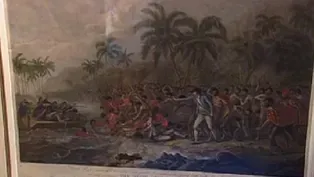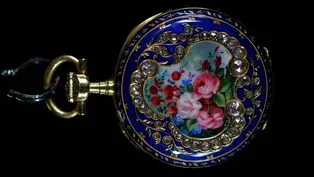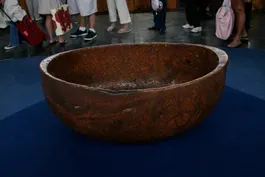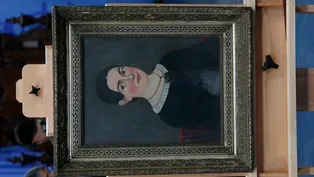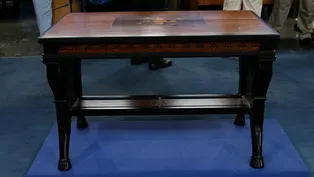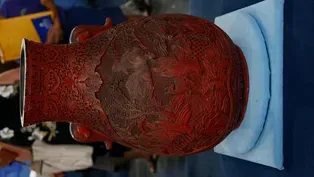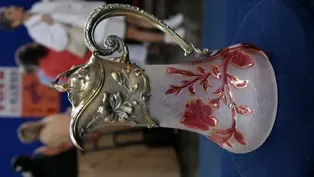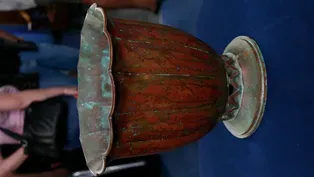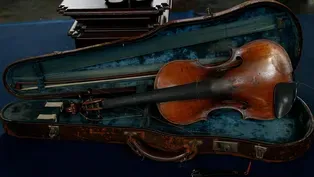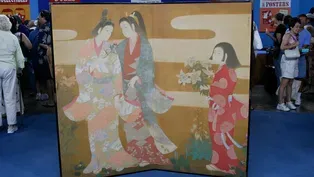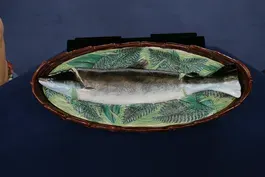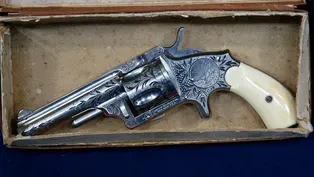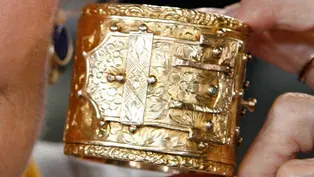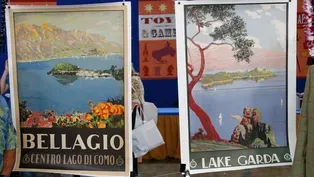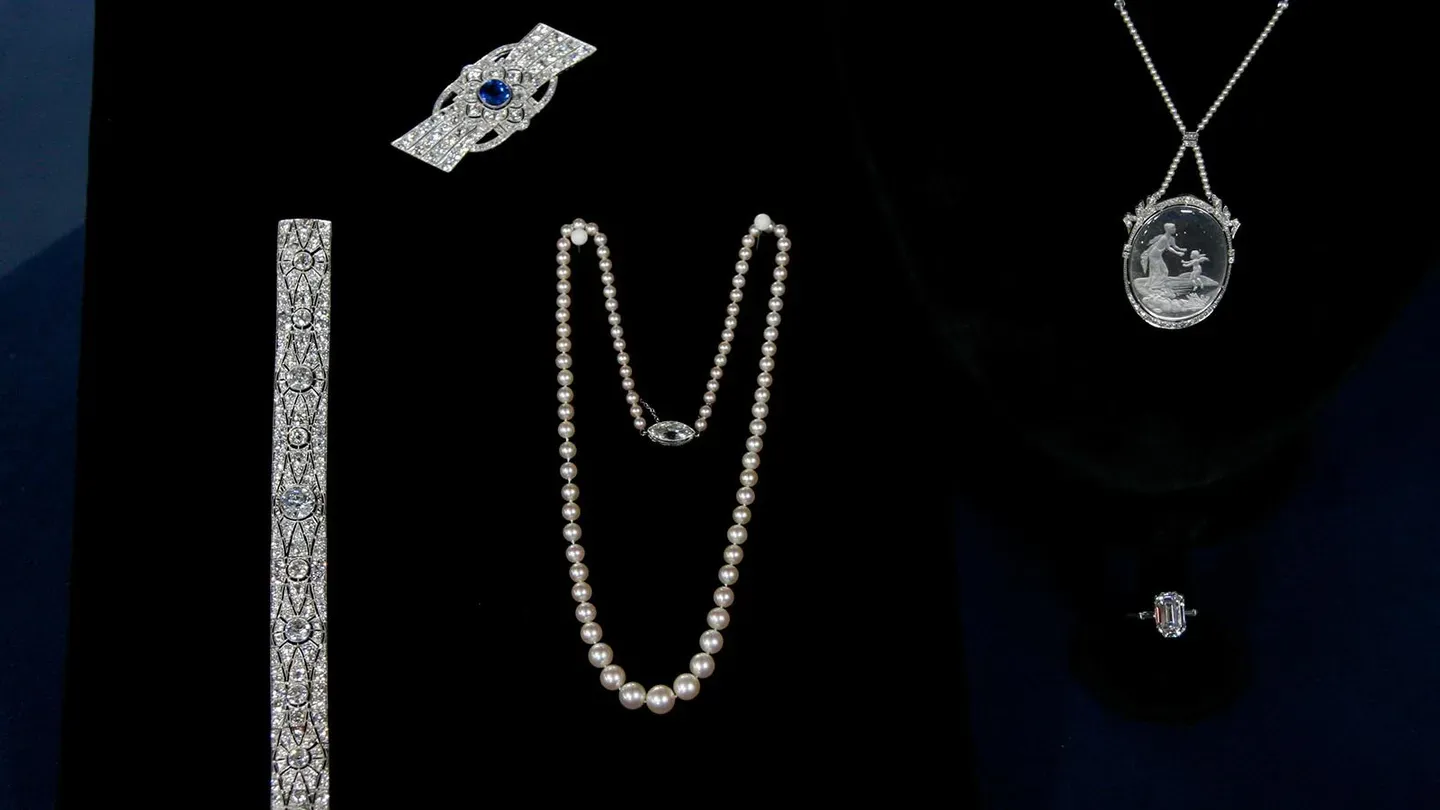

Vintage Honolulu
Season 24 Episode 16 | 52m 30sVideo has Closed Captions
Say Aloha to amazing appraisals revisited 14 years later including one that’s $250K-$300K!
Say Aloha to amazing Season 11 appraisals revisited 14 years later, including 19th-century Hawaiian poi pounders, a Dirk van Erp copper vase, and an 1888 Joseph Nāwahī oil painting. One is now worth $250,000-$300,000!
Problems with Closed Captions? Closed Captioning Feedback
Problems with Closed Captions? Closed Captioning Feedback
Funding for ANTIQUES ROADSHOW is provided by Ancestry and American Cruise Lines. Additional funding is provided by public television viewers.

Vintage Honolulu
Season 24 Episode 16 | 52m 30sVideo has Closed Captions
Say Aloha to amazing Season 11 appraisals revisited 14 years later, including 19th-century Hawaiian poi pounders, a Dirk van Erp copper vase, and an 1888 Joseph Nāwahī oil painting. One is now worth $250,000-$300,000!
Problems with Closed Captions? Closed Captioning Feedback
How to Watch Antiques Roadshow
Antiques Roadshow is available to stream on pbs.org and the free PBS App, available on iPhone, Apple TV, Android TV, Android smartphones, Amazon Fire TV, Amazon Fire Tablet, Roku, Samsung Smart TV, and Vizio.
Buy Now

ANTIQUES ROADSHOW 2025 Tour!
Enter now for a chance to win free tickets to ANTIQUES ROADSHOW's 2025 Tour! Plus, see which cities we're headed to!Providing Support for PBS.org
Learn Moreabout PBS online sponsorship♪ This is the type of thing that makes them weak in the knees.
This seems so, you know, a lot fancier than just a murderer's pistol, you know?
Yeah.
(chuckling): Whoa, okay.
I've got goose skin.
Thank you so much.
APPRAISER: Well, thanks for bringing it in, made my day.
♪ CORAL PEÑA: In 2006, "Roadshow" ventured far from the mainland to the island of Oahu and found an abundance of treasures from the Aloha State, including some Hawaiian poi pounders.
Think you know if the value of these stone beauties went up, down, or stayed the same?
Find out now in "Antiques Roadshow: Vintage Honolulu."
These are, it was in my family for a very long time.
These were my great-great- grand-uncle's poi pounders.
This is more traditional for poi pounding itself.
I think these were used more for either softening meat or making condiments with leaves.
We have a condiment in Hawaii, and it's called 'inamona, which made out of crushed kukui nuts.
So, as a kid, I do remember my grandma using it as she got older.
To soften her food, she used the smaller ones.
They are poi pounders, and poi is central to the Hawaiian culture.
Poi is made from the taro root.
This one is technically not a poi pounder, but it is a masher.
This is probably from the late 19th century.
And it's probably a found piece, because it's seriously abraded on the outside.
It's probably been abandoned somewhere, and the water has eroded it.
And you can see the metal staining where it's been standing on something.
This is also, the masher, shows a lot of wear.
It's perfectly proportioned.
This is for the first stage in the poi pounding.
These are actually the poi pounders themselves.
Okay.
This is also, like this one, probably 19th-century.
It's very, very difficult to tell exactly how old they are.
Right.
But given the wear and the aesthetics, I would think they're probably from the mid-19th century.
This is the little beauty.
This is made from a very fine-grained basalt.
Yeah.
It's extremely hard to find.
Right.
And would take a lot longer to make than something like this.
It's many, many man hours.
Right.
And the aesthetics, as you can see, this is more gradual and softly cut underneath here.
This has much more of a profile here with a beautiful mushroom shape on the top.
This is an extremely rare poi pounder and was probably made for the elite.
Have you any idea what they're worth?
My mom said maybe $1,000 for a stone.
I watched, uh, the "Roadshow" about seven years ago.
Uh-huh.
And somebody on the East Coast had, I think, an in-between size, and the appraiser at the time said $3,000.
This one, the found piece, they're quite common.
And I think probably between $400 and $600.
This one, which is a super one, I think, probably around about $4,000 to $5,000.
This little pounder, about $3,000 to $4,000.
And this one, which is the real choice piece here, I think conservatively, I would say $6,000 to $8,000.
Wow.
And that would be on the retail market.
It was all in a closet.
And probably it'll get wrapped up and go right back into a closet.
WOMAN: It's been mine for about 30 years, and it was given to me by my father.
And he purchased it in 1963 from the local auction house.
This is one of a pair that was in the Winter Palace in Peking.
The other one, we have no idea what has happened to it.
APPRAISER: This is called an elephant vase, and that's because of the elephant handles.
You often find this shape in very regal, impressive kind of locations, so it's natural that it could have been in the palace.
It's unusual to see it in lacquer.
Lacquer is from the sap of a tree, and the different layers are applied thinly, one on top of the other, and it takes about two to three days for each layer to dry.
So for a vase like this, there probably are literally hundreds of layers of lacquer.
So the time it took to construct this would have been considerable.
One of the first things that struck my eye is the lappets, which are these shaped forms descending from the neck.
Yes.
And the lotus decoration is deeply cut, but not terribly finely cut.
That, and the lack of presence of, of a mark on the base, doesn't necessarily mean it wasn't in the palace.
But it does probably indicate that this was not an 18th-century vase, but rather something created in the late 19th century, about 1880, made for the palace, and still a fine-quality object.
The problem with this vase is the condition.
Yes.
The deer antlers here are missing.
Yes.
And I'm going to spin it around.
And there's some quite severe damage running right through here, through the skyline.
And right here, somebody has put in plastic wood or something.
Yes, I just... To try to make a repair, and it's very clumsily done.
It was done before '63.
And the sales slip does say that it had been repaired.
And in 1963, it was-- $500 was the cost, right?
Yes, yes.
Okay, now, up until fairly recently, something like this with damage as extensive as this is, and dating from a late period, would not have been worth very much money.
But what's happened is, the Chinese market has grown.
So this has some, some value.
If this came up at an auction sale today, even with the damage, we would expect to get somewhere between $5,000 and $8,000 for it.
I see, thank you.
Had it not been damaged, I think that it actually would have been in that sort of $50,000- $70,000 kind of range.
Yes.
APPRAISER: "The Indigenous Flowers of the Hawaiian Islands."
The plates are of a high standard.
They're printed by this firm, Leighton Brothers.
And copies of the book do appear quite frequently at auctions.
It's very rare to have a pair of candlesticks.
We see a single stick from time to time, but to have a well-matched pair like this doesn't happen very often.
Yeah.
They are decorated all by hand.
They are carved and painted-- this is in a lily pattern.
This is called a bracket clock.
It was made by the Elliott Manufacturing Company in London.
It was made in the early part of the, of the 20th century, maybe 1910 to 1920.
It's larger than they usually are, and it's a, it's a very, very nice example.
Well, this was at an auction here in town, and I paid $3,000 for this about four years ago.
It's one of the great prints, and certainly the best print of the death of Cook.
James Cook, who was the discoverer of the Sandwich Islands, at least for the Europeans.
This image was done by John Webber, who was an artist who actually went with Cook on his voyages.
On his third voyage, at least, which was 1776 to 1780.
And, of course, Cook was killed in Hawaii, and this is the scene of that.
The event happened because of a debate over a stolen boat-- trying to get it back, things got out of hand, and there was a battle, and he was killed.
When Webber came back, he himself published this print.
This is his own separately issued print that he did to make his name, and it's a very, very rare print.
I would say today in our shop, if we had this print, we'd probably have about $6,500 to $7,000 on it, because it's a very, very rare print.
MAN: It's been in my family for at least 80 years.
My grandfather bought it sometime in the 1920s at a sale in Nova Scotia, Canada.
Family history has it that it's Mi'kmaq Indian from the East Coast of Canada.
My brothers and I were all pushed around the living room in, in this.
(laughs) You must have come from, you know, strong stock.
Well, this has created quite a stir.
And although everybody is of a like mind that it's Native American-made, and probably from the Canadian Maritime area-- one of those tribes-- nobody's exactly sure whether or not it's Mi'kmaq or Passamaquoddy or Malecite.
There are a number of tribes that are in that area.
The consensus amongst those of us who are here today, that it's made out of elm wood.
Elm.
Which is an indigenous tree to that particular area of the Northeast of America.
You see this elongated grain, which is typical of elm wood.
It's a burl bowl.
It's made out of that knot of burl that is particularly well suited to this kind of a container, because it doesn't split.
And so it makes it very adaptable for scooping out and shaping.
It's about 24 inches in length, it's 16-and-a-half inches in width, and about nine inches in height, so that makes it unusually large for this kind of a piece.
The value might have been around $15,000 ten years ago, but in today's market, it's probably worth, at auction, between $40,000 and $60,000.
(chuckling): Whoa, okay.
I wasn't going to be surprised, but you got me.
(laughing) It's just a fabulous, fabulous piece.
Wow.
And everybody's been talking about it.
And how old would you say it is?
18th century.
Wow.
MAN: They actually originally belonged to my great-aunt Indiola on my mother's side.
Aunt Indiola was married to a gentleman by the name of Clem Keys, who was a very important airline promoter and financier back in the early part of the century.
They lived in high-society circles in New York, and I believe that's where my aunt acquired them.
Later passed them on to my mother and eventually to me.
What we have here are a number of very interesting examples of what we consider Art Deco jewelry.
This is a engraved rock crystal and seed pearl and diamond necklace.
It's engraved in a neoclassical scene.
This here is an Art Deco bracelet encrusted with diamonds; a brooch with a Ceylon sapphire and a diamond openwork design.
The pearls here are natural pearls, pearls that are directly from the oyster-- there was no intervention by man to culture them-- which are very sought after in the 1920s, with a diamond clasp.
And last, in front here, we have a diamond ring.
Now, your diamond ring is very unique.
It's a large stone.
It's an elongated rectangle with cut corners.
This stone fits under the category of diamonds that we refer to as Golconda, from India.
And with Golconda stones, they have a particular phenomenon that occurs in them-- when they are exposed to light, when they're in daylight, they get super white.
Most diamonds are graded on a scale of D through Z, but even a Golconda would be a D-plus in terms of color-- it would be high, high up there.
These stones are white, the light dances in them.
They're very, very sought-after stones.
When you talk to a connoisseur of diamonds, and if you say you have a Golconda stone, this is the type of thing that makes them weak in the knees, basically.
Ah, great.
So, all these pieces date from the 1920s.
The bracelet itself would be mid-1920s to the late 1920s.
Now, there are no hallmarks on the item, but based on the craftsmanship, the type of workmanship, I would tend to think that this piece was American.
The brooch, also-- no hallmarks, but appears to be American, as well.
The pearls, these could be retailed by anybody during this period, and there's nothing indicative that says they're European or American, but more likely than not, since they were in New York, it was manufactured probably in the United States.
The diamond pendant necklace may be European.
This is much more in the European taste.
And in terms of the diamond ring-- there are no hallmarks on that, either-- it was manufactured in the United States, as well.
The first item here, the necklace, the fair-market value on this would be between $5,000 and $7,000 on the necklace.
Great.
The sapphire-and-diamond brooch, value on this would be between $10,000 and $15,000.
Wow.
The pearl necklace would be between $20,000 and $25,000.
Whew!
And the bracelet would be between $40,000 and $60,000.
Oh, my.
Now, for the diamond, our valuation for that at auction would be between $70,000 and $90,000.
Wow.
I really appreciate your bringing them in today.
Well, thank you very much.
It's great to hear these kinds of values.
MAN: I've brought in a pistol that's been in my family for a couple of generations, anyway.
My mother told us that her father, who was a federal district court judge in Wisconsin, took this gun after a murder trial.
The gun was apparently the murder weapon.
He presided over the trial, and the murderer, he was put away, he was found guilty.
And the gun's been in our family since then.
When was this?
That would have been in probably the 1920s or so.
He used to ride the circuit between northern Wisconsin and southern Wisconsin.
It was a little bit Wild West-ish, and also, it was Prohibition back then, and there was a lot of bootlegging in Wisconsin and through Wisconsin to Chicago.
Mm-hmm.
And do you know what the pistol is?
Just what the box says.
It's a .38 caliber.
The marking looks like it says "1877" on the pistol and in the box.
But other than that, no.
Yeah.
Well, 1877 on the pistol is the patent date.
Oh, okay.
And it was patented by the manufacturers Hopkins and Allen in Norwich, Connecticut.
Oh, okay.
Now, what this also says, it says "Merwin Hulbert."
Now, Merwin and Hulbert, they were the agents and dealers for Hopkins and Allen's.
Oh, okay.
Hopkins and Allen's was the successor firm to the Bacon Manufacturing Company, also of Norwich, Connecticut.
And they started business in 1868 and went on to make many hundreds of thousands of guns until 1915.
Merwin Hulbert, they represented Hopkins and Allen in the 1880s, so this pistol was probably made around the 1880s.
Which is interesting, because it was used in a crime at some time in 1920s.
What's also interesting, too, is the quality of the pistol, and, and that, you know, whoever used it must have been a gentleman.
Well, you see, I always thought that, you know, with all the engraving on it, it's really pretty.
Yeah, mm-hmm And I assumed, this seems so, you know, a lot fancier than just a murderer's pistol, you know?
Yeah, this is obviously a very deluxe pistol.
It has this fine engraved and punched scrollwork.
And it has this little scene panel of a game bird and these ivory grips, which have this wonderful, mellow patina.
Yeah.
What's also very special about this is, it's, it appears to be in its original box with the instructions on how to use it.
This also shows the international basis in, essentially, the arms trade, even in the 1880s, is because not only are the instructions in English, but they're also in Spanish.
Right.
Which meant that many of them were destined for export.
Well, in this condition and this quality, and with the original box-- even though the box has, obviously has some significant damage to it-- I would estimate at auction, it would probably fetch somewhere between $3,000 and $5,000.
Oh, my God.
Mm-hmm.
Oh, that's fantastic.
Yeah, thanks for bringing it in.
Oh, gee, thank you very much.
Well, it came from my parents, and I'm 62, and I can remember this as long as I lived.
I've always wanted it.
(chuckles) When my parents passed away, my brother had a custody of it for a little while.
Mmm.
And then I demanded it.
Ah, okay.
It's a wonderful, large-format, painted screen.
What do you know about it?
First of all, it's signed "Yoshihiko," but I couldn't find anything about this person.
My limited knowledge of Japan, looks like two courtesans with a attending child, probably late Edo period or maybe even Meiji period.
Well, it's a little later than that.
I think it's probably Taisho period.
The Taisho era follows the Meiji period.
Meiji period was from 1868 to 1912.
Right.
And the Taisho period was from 1912 to 1926, at a time where they were really interested in large-scale figures and designs, which actually showed the interaction between Western art and Japanese art-- the influence of Art Deco on large-scale decoration.
It looks like it's been a little bit faded.
Did you have something done to it?
My mother had it, it was kept in a dark place, but when I acquired it, it was in pretty bad shape.
So, some cleaning was done, and then it's hanged underneath a skylight.
I don't know if that has anything to do with it.
So it's been faded a bit, yes.
I believe it did, mm-hmm, slightly.
So you had it restored, then.
Repaired, more likely, yes.
I see, I see.
Tell me, what did you pay for the restoration?
$2,500.
Well, let me tell you, that was a very good investment.
(chuckles) It's done by Yoshihiko, who was a Taisho artist.
And Taisho is a very, very hot commodity, this period between 1912 and 1926.
I believe the Honolulu Academy of Art recently had an exhibition called "Taisho Chic."
That's what I've been told, yeah.
Right, exactly.
Even though the two-paneled byobu, or screen, as it's called, is faded and has had some restoration, it still, on the auction market, would be estimated at about $7,000 to $10,000.
(chuckles): I'm glad I brought this here.
Thank you very much for bringing it in to us.
Thank you.
The form here is called lian, and it applies to a cosmetics box.
It's an archaic bronze, and a very, very plain one.
The Han sometimes used to inscribe these with gold with their weights on them, because the metal was extremely valuable.
But still a nice bronze.
Oh, it's beautiful.
We love it.
It's a good patina, too.
Bright, nice malachite surface.
APPRAISER: This is a Selmer Mark VI.
To the alto player, the tenor player, soprano player, a Mark VI has always represented one of the finest horns.
And all of the engraving is very nice.
I got it at a thrift store here in, in town, in Honolulu.
In Honolulu?
Yeah.
And what did you pay for it?
Uh, maybe ten dollars, if that.
Wow.
Well, it's really rich, visually.
It's got a lot going on.
That's what I like about it, yeah.
All the animals-- really fanciful.
There's actually monkeys in it, wild serpents.
It was made in Persia, probably made about 125 years ago, right?
That long?
1890, 1900.
Whoa, whoa.
Yeah.
And my guess is that at an auction, probably worth about $3,000.
(chuckling): $3,000?
Does that surprise you?
Yes, it does, 'cause... And...
It really does.
It's got a few condition problems.
Right, right, If it were in better condition, it might bring as much as $10,000.
MAN: Well, when I was stationed in Stuttgart, Germany, they were at flea markets downtown there.
One day, a guy had these, they were, they were actually kind of beat up, particularly this one.
Define "beat up" for me.
A lot of this, like, I honestly got from watching the "Roadshow" before.
It had some water stains, I guess, is what it was, in this upper field here, and then down here, this was really trashed and, and was falling apart.
So what I did was, when I got back to the States, I shipped it in a place in New York that does restoration and linen mounting, which is what they call this, and-- again from the "Roadshow."
And I actually paid more for the linen mounting and the restoration, and the shipping that was associated with, than I, than I think I did for the poster.
I think I paid 300 marks for both of them.
And what is that in dollars?
That was, it was, like...
It was around $200, something like that.
And how much did you pay to have them restored?
A bit, a bit more than that.
It was, it was, like, $100 each.
I think I paid a little bit more for this one, 'cause they had to do more work for it.
And then the shipping cost back and forth, I bet I'm into them at around $500.
I was trying to get you to define "beat up."
I think "beat up" might have actually been a nice word.
Beat up, put through the wringer, torn, shredded.
They were pretty, they were torn up, yes, sir.
If you look closely here, you'll see they've actually recreated paper that was missing.
You can see here where they've pieced in some losses, where they've repaired some very prominent creases.
One thing I'd like to show people is the whole linen-mounting process.
The linen itself is, is like canvas.
Right, feels just like canvas.
And on top of that, they have put acid-free paper onto which the poster has then been mounted via a completely reversible process.
Now, I always say to people, when they're done professionally, if you were to take this into the bathtub with you, it would float right off.
I don't plan on doing that.
And I don't recommend it, either.
But it is a completely reversible, museum-quality process.
And once the poster has been mounted onto the linen, then they can begin repainting areas, filling in areas.
What would you imagine they're worth now?
I'd be speculating, maybe $500 each, it'd be... That's just a guess on my part.
It's a fair speculation, but it's wrong.
The Bellagio poster I've actually had for auction before.
In better condition, okay?
And it sold for $1,900.
Wow.
In this condition, even with the restoration, I would estimate it at $1,200 to $1,800.
Excellent.
All right?
And the Lake Garda poster nearer to me, which is in better condition overall-- albeit trimmed on both the top and the bottom-- I would estimate at the same price, at $1,200 to $1,800, bringing the total combined auction estimate of these two pieces at $2,400 to $3,600.
Excellent, nice.
We love them, we're keeping them, but that's great.
WOMAN: This violin belonged to my Great-Aunt Marie, who's pictured over here.
She was a violinist in the Cincinnati area in Ohio.
She moved out here and brought this one with her along with several others, and it's just basically been sitting in storage for 40 years.
APPRAISER: And this violin was bought for her by her father.
So here we have a bill of sale from the Rudolph Wurlitzer Company in Cincinnati, September 27, 1921.
Rudolph Wurlitzer attests that this violin is a Camillus Camilli from 1737 made in Mantua, Italy, for the tremendous sum of $1,000 back in 1921.
I'm not going to say it's in tough shape, because all of these things can be cleaned up.
But the strings are broken.
Because the strings are made out of gut, I can tell it really hasn't been played for at least 30 or 40 years.
The workmanship on it is very, very fine, and we see a lot of details that speak of the Mantua school of making.
Now, Mantua was only about a half a day's stagecoach ride from the great city of Cremona, where Stradivarius worked.
So the makers of Mantua were very influenced by Stradivarius and almost equaled his level of work in the later 18th century.
You have a very fine spruce top that's carved to a, a very flat and full arch, and that's very much the powerful Mantua style, creates a beautiful sound that projects very, very far.
We look at the detail on the back and sides.
The first thing that struck me was the type of wood used in the back.
These curls in it denote the species that is known as oppio in Northern Italy, and it grows only in Northern Italy.
Done very, very closely in the Italian style.
It's a little bit rugged.
We see some texture on the surface from the tool marks.
It's a very high-quality violin, but it's not Camilli.
It is a very fine forgery.
They try to attend to every detail in it, right down to the label, which reads "Camillus Camilli fecit, Mantua, 1737," and it's written in Latin.
And we can also see that it has a certain registration number that corresponds to the Wurlitzer Company certificate, and it's certified as number 3210 in their catalogue.
But this violin, being a very fine fake, still has some value, and that value at an auction sale was between $6,000 to $8,000.
The bow's in really rough shape.
But as we take it out, we see that it's made of very fine Pernambuco wood.
It's a French bow.
That stamp under a magnifying glass is just barely discernible.
But it says "Caressa and Français, Paris."
And Caressa and Français was a very fine shop in Paris which employed a lot of French bow makers who were the best of their time.
We know by two things who the maker of this bow was.
First by this ferrule, has a very rounded front.
And the other detail is that the very front has a very definite style that only one maker employed, and that maker was Claude Thomassin, and he was one of the top makers of the 20th century.
The value of the bow is about the same as the value of the violin.
Wow.
And that is about $6,000 to $8,000.
Wow.
If it were a real Camillus Camilli, it would be worth about $250,000 to $300,000.
Jeez.
It was made for my mother's half-brother when he was a baby, so I'm guessing probably around 1915, 1916.
And it's pretty much been in my family ever since, and it was passed on to me.
I don't know who made it for him.
I just know that it was made for him when he was a baby.
It is the coat of arms of King Kamehameha, who was the king who formed the Association of Hawaiian Islands and joined the eight islands together.
Mm-hmm.
And this is the royal crown here.
These are the royal ceremonial staffs.
This is the ancient outriggers' flag, and it has the crossed spears here, the influence of the British flag, and then the stripes for the various islands that made up the Hawaiian Islands after annexation in 1898 by the United States.
The quiltmakers took great liberty in making these quilts, so you won't always find them with eight stripes.
The women who made these quilts always put the quilting one finger apart.
So if you look at any of the quilting on this, each line of quilting will be one finger apart.
They were quite common right after annexation.
Hmm.
So it would be from 1900 to 1920, which fits in perfectly.
I think this quilt is in magnificent condition.
Now, how have you preserved it?
(chuckles) Rolled up in an old sheet in the closet.
That's probably as good a way to preserve it as any.
It's better to roll a quilt rather than to fold it.
Okay.
Now, do you have any idea of what this is worth?
Well, I know about ten years ago, a dealer offered my dad about $5,000, but my dad said absolutely not.
He didn't care, he was keeping it in the family.
This quilt in an antique shop today has a value of $25,000.
(snorts) (laughing): Okay!
These are called Pools of Light.
Oh...
Okay.
Isn't that a lovely name?
Yes.
This is rock crystal and it does not have a hole drilled through it.
There's no hole at all.
There's little sterling loops on the outside of each crystal.
I see.
This piece was made by Henry Bruns, Jr., in his furniture factory called the Hawaiian Furniture Factory, which was in business between 1880 and 1885.
This is a marvelous and very sophisticated piece of koa and kou.
You've taken wonderful care of it, and it's been in the family.
You know, it's a real Hawaiian treasure.
It has to be said, but holy cow.
(laughing) I love it!
What exactly did you bring us today?
Best of my knowledge, Tom Caulfield and Andy Warhol met at some point, and Tom Caulfield worked at the Royal Hawaiian from the '70s to early '80s.
My husband was the house photographer... At this hotel in Honolulu?
Uh-huh, yes, sir.
So it was gifted to your husband.
It's a color screenprint by Andy Warhol.
This print was actually made by a wallpaper studio in New York, and it's sort of a, to me, a classic Pop image.
It has all that you want in a Pop image.
Yay, mm-hmm.
You've got the appropriation of sort of an everyday thing-- a cow... Yeah.
Made into this monumental art.
You know, it's with the bright colors, with the signature on them, of course, that's what that... With the ink signature.
Mm-hmm.
His market has shot up dramatically in the last ten years.
Hmm.
So now at auction, you're looking at about $8,000 to $12,000 for this.
Wow, how exciting!
And it might even be more than that.
Wow!
Anybody want to buy it?
APPRAISER: I didn't expect to have to come to Honolulu to find a piece from the East Coast.
Do you know where this piece is from?
WOMAN: Greenwich, Connecticut.
That's where my grandfather lived.
Okay.
And so that's where we... he brought it from.
So he brought it from Greenwich.
And how did it come to you?
My grandfather was living in Kipahulu on Maui.
He and my grandmother were there and they needed some help.
So my husband and I moved over there.
My grandmother died, and so I was taking care of him, and by this time, he had shipped some of his pieces from Greenwich out to his house because he lived there full-time.
Okay.
I ended up with this piece.
I love this because I live and breathe wonderful wood, and 18th-century furniture, okay?
That's what... that's what makes me tick.
Okay.
I don't know if you know, but it does, okay?
(laughing): Okay.
This was made right in Philadelphia about 1745 to 1750.
Wow.
It's called a dressing table.
In the trade, we call it a low boy.
These dressing tables, or low boys, were made with a high chest, a tall piece.
Uh-huh.
They basically were sold together.
Right.
And then they often get separated.
So somewhere out there, there's a mate to this.
This molded top is above this long drawer.
It has a molded edge.
And then below here, you have three drawers.
And you have this wonderful cyma curve and this very baroque arch here with a little drop.
Uh-huh.
And it's all supported by these cabriole legs.
And you come down to that foot, and some people call it a Spanish foot.
This type of foot was typical of the best made in Philadelphia.
The top is this wonderful tiger maple.
And tiger maple is something that wasn't just grown.
You know, you had to cut the tree.
You had to go through a lot of maple to find a piece of wood that had this kind of fiddleback.
I know this is loose because I lifted it up before, right?
Right.
So I'm going to carefully lift this.
If I just take this board-- it's a two-board top, right?
Uh-huh.
And just put it like this, you'll see that the tigering, the curly figure on the inside of the case, matches that on the top.
It's clearly from the same wood source.
Also, the oxidation, the discoloration from being exposed to the little bit of air that was getting in there?
Uh-huh.
Matches.
So we know that those two pieces of wood-- the side of this case and this top-- have been next to each other, we feel, for about 250 years.
I mean, that's a good thing, right?
Right.
(laughs) Okay, but watch this.
We've got to make sure that all the holes on the top match the holes on the case.
On there, uh-huh.
Right?
The attachment holes?
We do that and see that there's a big old hole right there.
There's no hole there.
Right.
But I was here with my colleagues, and one said, "Leigh, slide the top over."
When you slide the top over about an inch and a half, look.
Uh-huh.
That whole matches that hole.
Right.
And this hole matches.
And if I take my finger from these two holes, and go like this, here's the hole here, and there's a shank of a nail right there in the top of that leg.
This is the original top.
They shaved it down.
It must've gotten damaged on the edge or something.
With the top original but reshaped, the value of this-- on the East Coast, let's say, it's probably worth a little more on the East Coast-- would be about $12,000 retail, okay?
That's what it's worth.
Oh, wow.
Now, let me tell you what it would be worth if it hadn't been cut.
The original.
Because condition's so important of American furniture.
Right.
Uncut it would be worth about ten times that, about $120,000.
(chuckles) Oh, boy.
I mean, this happened 150 years ago.
Yes, they cut it.
So it's nothing you did.
It's nothing I did.
If you told me, "Leigh, I did that last week," I think you'd be a little more bummed out, right?
Right, right, right.
APPRAISER: You brought this piece to be appraised, which was your mother's.
WOMAN: Oh, yes.
She was a collector of jewelry, and this was a fabulous piece.
She told me it came from Siberia.
What was your mother doing in Siberia?
Well, as a teenager, she was with my father at the time, and they were traveling the world on their expedition to create a world peace.
Yes.
They stayed with families in each country, and in Siberia, they stayed with a nice family there.
And on departure, they dug this up from where they were hiding their precious things.
So they gave this to Mom.
I tested it with jeweler's acid, which is how we can do it when it's not marked.
And it is solid 18-karat gold and... Quite substantial.
Heavy, and the weight, yes.
I don't have a scale that goes this high for gold.
I would say it's at least a quarter of a pound of 18-karat gold.
But the work is extraordinary.
I also pored over this bracelet, looking for a Russian mark.
There's absolutely nothing on it to indicate a country of origin, which is not unusual in antique jewelry.
They just didn't always mark things.
This is what would be called properly a cuff bracelet.
Yes.
It's a hard bracelet that's hinged with a catch.
And the motif is a buckle.
And the buckle is applied, but in matching decoration.
There's engraving of flowers beneath the buckle.
Mm-hmm.
And if we spin it around, we will see engraving on the underside, or the back of the bracelet.
And this has a crane and a swallow, which was a favorite Victorian motif, and a floral design.
So we have a very wide, heavy, important 18-karat-gold bracelet, which I would date from the 1870s.
Yes.
In the retail environment, a bracelet like this would easily command $12,000.
Mm.
In a retail store specializing in fine antique jewelry such as this.
How interesting.
But at auction, it might... pull in more.
Could be more at auction, could be less.
One never knows, though.
Depends on who's there that wants to fight over it that day.
Yeah, well, it's so bloody unique.
Yeah, it is unique.
WOMAN: I inherited it from my father's cousin's wife.
She apparently had it from my father's grandmother.
It's always been referred to as the fish dish in the family.
And what part of the country did they live in?
Upstate New York, in the Albany area.
This piece is pottery, and it's called majolica, which is a type of pottery that was very popular in the late 19th century.
A lot of it was made in England, but it was also made in the United States, as well as France and Germany, and other places in Europe.
Mm-hmm.
For a good piece of majolica, you like it to be very crisply modeled, like this one is.
You could see the scales on the fish are in the modeling.
Yes.
And then these wonderful ferns and leaves in the background.
Also, the base has this basket shape, so as if the fish and the plants were in a basket.
The inside has this wonderful pink lavender color.
The more color, the better it is for collectors.
Now, there is a faint mark here, which you had asked me about earlier.
And you said that you thought it was the manufacturer's mark.
And that is the logical thing to think.
Yeah.
The mark is right here, and when it was fired, the glaze ran into the mark and kind of filled it up.
So it's completely illegible.
It's a vertical mark.
This is the top here.
It's an English registration mark.
Within this diamond are little sections.
And if we could read it properly, there would be numbers and letters of the alphabet in those sections, and we could look it up on a chart and see exactly what year this particular piece was registered.
It dates from about 1870.
Oh, really.
The manufacturer's mark is not here.
I've looked very carefully with magnification, and I could not find it.
But I'm almost certain that this piece was made by a company called George Jones and Sons, and they were well-known for making really wonderful majolica.
I always found it interesting that the bottom, the base, had been glazed, on the underside.
Right, and that's just the way they made it.
The side it sat.
This is a very popular piece with majolica collectors, and it is a known piece.
A retail price in an antique shop, or antique show, something like that... Mm-hmm.
Would probably sell for somewhere between $2,500 and $3,500.
Oh, really?
And in some cases, it might sell for a bit more.
That's wonderful.
Thanks very much for coming in.
It was a treat to see, and I'm glad you brought it in.
Thank you.
This is a letter that Jackie Kennedy wrote to Duke Kahanamoku.
She had come to Hawaii and visited him, and this was a thank-you letter that she wrote.
She came to Hawaii and just, still recovering from the death of her husband.
APPRAISER: Carl Brandien met his wife on a steamer going to California, and they started a thing called vagabondage, and their goal was to travel all around the world and find beauty, and paint it.
And between 1930 and 1937, they visited many countries.
APPRAISER: We often talk about horse-drawn cast-iron toys stopped being made when World War II came along.
These are the few survivors that were made after the war.
The originals would have metal wheels, carrying wheels, instead of the rubber.
That's one of the key indicators to know that it's postwar production.
Even postwar, in this kind of condition, it's just unheard of.
I paid about $45 for the mask.
Okay, now, you think it's African?
I think it could be.
It was, it was with African masks at a flea market in Albuquerque.
All right.
I believe this thing is correct.
It's a Lwalwa mask, and it comes from a tribe on the border of Angola and Zaire.
About 20,000 people.
This is a female mask because it has a narrow nose.
The male masks are triangular.
What is bizarre about this piece, and what is a real no-no, is, somebody tried to improve it.
Somebody sanded it here and here, and even a little bit on the nose up here.
And on the side.
You never touch a mask.
We look inside to see if it's old, and we see a wonderful surface along here, on the inside.
It's an old mask, but it's a mask that would be worth a heck of a lot more money if somebody hadn't messed with it.
All right?
Now, the good news is, as is, this mask is probably $2,000 to $3,000.
Wow.
Did that put you in a good mood?
Yeah, that's really good.
Now, if somebody hadn't messed with it, it would probably be worth twice that.
Oh-- oh, okay.
I would like to ask you where you acquired this piece.
In America.
In, um, what you call?
Estate sale.
It was very black.
Very, very black.
And I always feel I know underneath what it will be.
And underneath, I saw it came from France.
Can you share with us what you paid for it?
Well, it was more than 45 years ago.
I bought it for $50.
It is a Daum piece.
We can see the "Daum Nancy."
Right.
And the cross of Lorraine.
Yes, right.
Very interesting.
They were one of the top cameo glass companies in the world.
Mm-hmm.
It's highly desired today.
It was collectible 40 years ago, but not like it is today.
The unusual part about this piece is that it has sterling fixtures.
We see here a hallmark.
And that is the Gorham factory in the United States.
Oh!
Yes!
So you have a French glass and then you have an American fixture.
Oh, top-- hmm.
The glass is acid-cut back cameo with fire-polished floral decoration and gilded highlights.
They experimented for a long time to get this gold gilding.
And that happened about 1890.
The piece would be in that 1890 to 1920s time period.
If I had this in a nice, fine antique show, I would have it priced between $3,000 and $4,000.
I want to thank you so much for bringing it.
Oh, thank you!
Wow!
I can't believe!
My mom gave it to me.
She actually got it at a silent auction about ten, 15 years ago.
She paid about $100 for it.
And you know who it's by?
You know who the maker is?
I think it was Dirk van Erp.
Dirk van Erp.
Well, he's really a very interesting craftsman.
Uh-huh.
He emigrated to the United States from Holland in 1886, and he started work in San Francisco at the Naval Shipyard.
And he started making things out of brass shell casings.
He would give them away to friends, and he started selling them.
Right.
And then he set up a shop, in Oakland, and eventually moved to San Francisco in 1908.
And he had a shop where he produced copper works.
He had his two children work with him, and he had a number of other craftsmen.
And they made vases.
they made bookends, desk sets, and they made lamps, which they're very famous for.
The piece what you have, though, is not from this Arts and Crafts period.
I feel that this piece is actually from the 1930s.
But really, all the emphasis on collecting his works is in the earlier period.
Uh-huh.
And these later pieces are not of interest to collectors of Arts and Crafts.
These are more collected by people interested in the Modernist '30s and '40s.
It's made out of a very heavy-gauge copper, and it's very clearly marked.
And it's been detached from the base.
Uh-huh.
And if we look in, on the bottom here, we can see his mark.
Uh-huh.
And it's a windmill, in honor of his home country, and it says "Dirk van Erp."
So it has some condition problems.
Right.
The fact that it's detached doesn't mean that much.
It can be repaired.
Really?
It's a piece that now, a collector interested in this would probably at auction pay something in the range of $6,000 to $8,000.
Wow.
That's something else.
Isn't that cool?
That is cool.
WOMAN: I inherited it.
I've never seen the inside of it before, and I wasn't even sure that they were real diamonds, so I don't know anything.
APPRAISER: The first thing you notice is, it's very beautiful.
Beautiful.
It has all this... pretty French enamel.
That's probably where this enamel was put onto the case.
Intertwined with the enamel, we do in fact have diamonds.
They are what we call rose diamonds, and rose diamonds have a flat bottom, and they're faceted with just a few facets on top.
Now, if we had a watch like this-- the diamonds, enamel-- it may be a $1,500 to $2,000 watch.
But your watch is a little bit better.
If we flip it over now... Beautiful white porcelain enamel dial, and we see that it's signed by Tiffany and Company.
Tiffany and Company didn't make watches.
They're the company that retailed them.
Now we have a watch that's probably worth $3,000 to $4,000.
(laughing): Oh, God.
Oh, dear.
There was a company that started using Tiffany as one of their main retailers of their product in New York in 1854.
If we turn the watch back over and we open up the case, it tells us it's made by Patek Philippe and Company, which is the finest maker of Swiss watches in the world.
There may be some just as good, but there's none better.
And there's also a serial number in here.
If we look up the serial number, this watch was manufactured in 1890.
So now we have the diamonds, the rose diamonds, the enamel.
We have Tiffany and Company.
Now we have Patek Philippe.
You ready?
Yes.
$8,000 to $10,000 at auction.
Oh, good grief-anelli.
Oh, that's unreal.
You have to start wearing it, somewhere.
I'll wear it every time I watch the "Antiques Roadshow."
(laughs) It's signed down here "J. Nawahi, 1888."
Joseph Nawahi, he wasn't primarily a painter, was he?
No, that's probably the least of his known attributes.
He was a lawyer.
He was a legislator.
He was an educator.
And he was a publisher of a newspaper.
He was in the legislature for 20 years.
He produced a newspaper critical of the rebellion and the overthrow of the government.
And actually landed in jail from around 1893, '95, and subsequently caught tuberculosis and died in '96.
Yes.
But he was a native-born Hawaiian.
You see these two snowcapped peaks here.
Uh-huh.
And, and those are...?
They're the two mountains on the Big Island, they're Mauna Kea and Mauna Loa.
Right, the two volcanoes there.
Right.
This bay here is probably where?
It's the Hilo Bay.
On the Big Island.
Right.
And then this island there?
It's called Coconut Island.
He was an amateur painter, and you look at the figures, sometimes the anatomy and the perspective isn't always right.
They're a little bit stiff.
He's a good artist, but not a great artist.
He has a good sense of the, uh, the landscape, but he's not an academically trained artist.
Yeah.
He had some training, but not much.
But it's important because he's the first Hawaiian-born to paint in this Western style.
He was known for doing volcanoes, much like Jules Tavernier.
There aren't many paintings by him.
I think he-- how many are there, do you think?
No, we only know of five.
This is either the largest or one of the two largest ones.
Where'd you get it?
Well, we were on our way from our property up in Volcano down to Hilo Town to go to a museum, and we stopped on the way at our favorite antiques gallery, saw this, couldn't quite make out the artist's name, but got a fix on it, and we had to rush off.
So we went down to the museum and we saw his name there.
My husband and I, we looked at each other, and we said, "The painting!"
Called the antique shop and asked them to hold it, and we zoom back up there, and we got the painting.
I think we paid about $400 for it.
About $400.
That was in the '70s.
It was very dark and it was grazed.
The old painting had cracked and everything.
So a friend of ours sent it to his restorer in San Francisco, I think it was-- it's somewhere in California-- and so we did have him do that.
That has an effect on value on anything, but when you talk about five or six pieces that are known... Uh-huh.
We sort of forgive some of the condition issues.
Do you remember what you paid for the restoration?
Probably between $600 and $900.
I consulted with one of my colleagues here who's from the islands.
Because you have the Hilo Bay, you have Mauna Loa, Mauna Kea, he called it Hawaiian gold for... Hm.
In the, in the art market.
Recently, works by him have sold as much as $70,000.
I think if this were to be up at auction today, I would probably put an estimate of $100,000 to $150,000 on it.
Are you kidding?
No, it's a great thing.
Wow.
(laughing) Wow!
It's really important.
This is a national treasure, I mean, it's an amazing thing to have here, this... Well, I'm native Hawaiian.
Yeah.
So it's one of the reasons we bought it.
No, it's great.
Oh, gosh.
(laughs): I've got goose skin.
Well, take good care of it.
You know, and put it in a very safe place, and keep it under lock and key.
We're very proud to have this picture.
Yeah.
Thank you so much.
All right.
Well, thanks for bringing it in, it made my day.
(chuckling): Thank you.
PEÑA: You're watching PEÑA: And now it's time for the Roadshow Feedback Booth.
I found my bottle is worth $100.
And I'm from Maui.
As "Antique Roadshow" viewers know, beautiful words are "beautiful patina."
Beautiful patina because... Because this is a desk set from Tiffany Studios that we thought was only $600, and it turned out to be worth $3,000.
Mahalo!
Mahalo.
They told me that my wicker lamp, if it was still white, it would be worth a lot of money, but I wouldn't paint it white for all the money in the world.
And I found out that I have a buttocks basket, because of the shape of the basket.
It's been in my family, um, for many years.
As it turns out, according to the professional, it's a fabulous, fun, fiberglass fish from the '50s.
Aside from that, not much else was known, but, uh, that's fun enough.
(laughs) We had such a great time.
It was just a ball.
And now I think I'm even going to go home and play my violin.
I'm not worried about it costing $70,000.
It's only worth $200-- who cares?
And we'd like to say aloha and mahalo to "Antiques Roadshow" for coming to Honolulu.
We loved seeing the Keno brothers!
Even though we didn't have any furniture.
And mahalo, a hui hou!
Bye!
Bye!
PEÑA: Thanks for watching.
See you next time on "Antiques Roadshow."
Appraisal: 1784 John Webber Captain Cook
Video has Closed Captions
Clip: S24 Ep16 | 1m 11s | Appraisal: 1784 John Webber Captain Cook (1m 11s)
Appraisal: 1890 Patek Philippe & Tiffany Pocket
Video has Closed Captions
Clip: S24 Ep16 | 2m 4s | Appraisal: 1890 Patek Philippe & Tiffany Pocket (2m 4s)
Appraisal: 18th - Century North American Indian Burlwood
Video has Closed Captions
Clip: S24 Ep16 | 2m 20s | Appraisal: 18th - Century North American Indian Burlwood (2m 20s)
Appraisal: 19th-Century Hawaiian Poi Pounders
Video has Closed Captions
Clip: S24 Ep16 | 2m 53s | Appraisal: 19th-Century Hawaiian Poi Pounders (2m 53s)
Appraisal: 19th Century Prior-Hamblin Folk Portrait
Video has Closed Captions
Clip: S24 Ep16 | 1m 5s | Appraisal: 19th Century Prior-Hamblin Folk Portrait (1m 5s)
Appraisal: Aesthetic-style Library Table
Video has Closed Captions
Clip: S24 Ep16 | 28s | Appraisal: Aesthetic-style Library Table (28s)
Appraisal: Chinese Red Laquer Carved Vase, ca. 1880
Video has Closed Captions
Clip: S24 Ep16 | 2m 42s | Appraisal: Chinese Red Laquer Carved Vase, ca. 1880 (2m 42s)
Appraisal: Daum & Gorham Mfg. Co. Ewer
Video has Closed Captions
Clip: S24 Ep16 | 2m 16s | Appraisal: Daum & Gorham Mfg. Co. Ewer (2m 16s)
Appraisal: Dirk van Erp Copper Vase, ca. 1930
Video has Closed Captions
Clip: S24 Ep16 | 1m 56s | Appraisal: Dirk van Erp Copper Vase, ca. 1930 (1m 56s)
Appraisal: Hawaiian Flag Quilt, ca. 1915
Video has Closed Captions
Clip: S24 Ep16 | 2m 20s | Appraisal: Hawaiian Flag Quilt, ca. 1915 (2m 20s)
Appraisal: Italian Violin & French Bow
Video has Closed Captions
Clip: S24 Ep16 | 4m 3s | Appraisal: Italian Violin & French Bow (4m 3s)
Appraisal: Japanese Panel Screen, ca. 1920
Video has Closed Captions
Clip: S24 Ep16 | 2m 38s | Appraisal: Japanese Panel Screen, ca. 1920 (2m 38s)
Appraisal: Majolica Fish Tureen, ca. 1870
Video has Closed Captions
Clip: S24 Ep16 | 2m 43s | Appraisal: Majolica Fish Tureen, ca. 1870 (2m 43s)
Appraisal: Merwin Hulbert Pistol, ca. 1880
Video has Closed Captions
Clip: S24 Ep16 | 2m 53s | Appraisal: Merwin Hulbert Pistol, ca. 1880 (2m 53s)
Appraisal: Philadelphia Tiger Maple Lowboy
Video has Closed Captions
Clip: S24 Ep16 | 3m 24s | Appraisal: Philadelphia Tiger Maple Lowboy (3m 24s)
Appraisal: Victorian Gold Cuff Bracelet, ca. 1870
Video has Closed Captions
Clip: S24 Ep16 | 2m 39s | Appraisal: Victorian Gold Cuff Bracelet, ca. 1870 (2m 39s)
Appraisal: 20th-Century Italian Travel Posters
Video has Closed Captions
Clip: S24 Ep16 | 2m 57s | Nicho Lowry appraises two Italian travel posters in Honolulu Hour 1. (2m 57s)
Providing Support for PBS.org
Learn Moreabout PBS online sponsorshipSupport for PBS provided by:
Funding for ANTIQUES ROADSHOW is provided by Ancestry and American Cruise Lines. Additional funding is provided by public television viewers.


